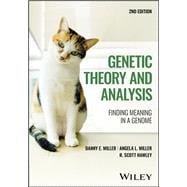Understand and apply what drives change of characteristic genetic traits and heredity
Genetics is the study of how traits are passed from parents to their offspring and how the variation in those traits affects the development and health of the organism. Investigating how these traits affect the organism involves a diverse set of approaches and tools, including genetic screens, DNA and RNA sequencing, mapping, and methods to understand the structure and function of proteins. Thus, there is a need for a textbook that provides a broad overview of these methods.
Genetic Theory and Analysis meets this need by describing key approaches and methods in genetic analysis through a historical lens. Focusing on the five basic principles underlying the field—mutation, complementation, recombination, segregation, and regulation—it identifies the full suite of tests and methodologies available to the geneticist in an age of flourishing genetic and genomic research. This second edition of the text has been updated to reflect recent advances and increase accessibility to advanced undergraduate students.
Genetic Theory and Analysis, 2nd edition readers will also find:
- Detailed treatment of subjects including mutagenesis, meiosis, complementation, suppression, and more
- Updated discussion of epistasis, mosaic analysis, RNAi, genome sequencing, and more
- Appendices discussing model organisms, genetic fine-structure analysis, and tetrad analysis
Genetic Theory and Analysis is ideal for both graduate students and advanced undergraduates undertaking courses in genetics, genetic engineering, and computational biology.








